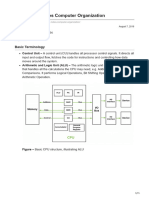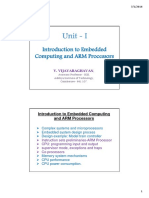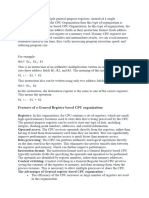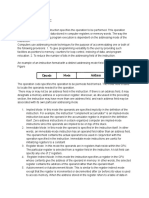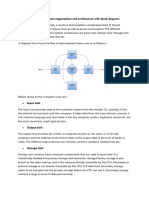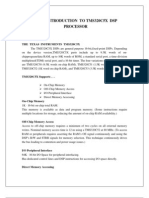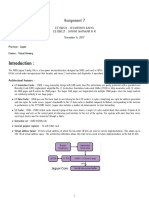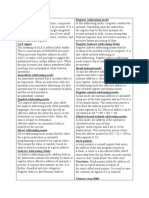0 ratings0% found this document useful (0 votes)
69 viewsData Processing Instructions
Data Processing Instructions
Uploaded by
mani_vlsiThe ARM architecture provides a range of arithmetic, logical, and data processing instructions. It supports addition, subtraction, bitwise operations, and multiplication on 32-bit operands stored in registers. Data transfer instructions allow single-register and multiple-register transfers between registers and memory using various addressing modes like base-plus-offset. Auto-indexed addressing updates the base register to access sequential memory locations efficiently. Control flow instructions include conditional and unconditional branches as well as conditional execution of any instruction based on status flags.
Copyright:
© All Rights Reserved
Available Formats
Download as DOCX, PDF, TXT or read online from Scribd
Data Processing Instructions
Data Processing Instructions
Uploaded by
mani_vlsi0 ratings0% found this document useful (0 votes)
69 views1 pageThe ARM architecture provides a range of arithmetic, logical, and data processing instructions. It supports addition, subtraction, bitwise operations, and multiplication on 32-bit operands stored in registers. Data transfer instructions allow single-register and multiple-register transfers between registers and memory using various addressing modes like base-plus-offset. Auto-indexed addressing updates the base register to access sequential memory locations efficiently. Control flow instructions include conditional and unconditional branches as well as conditional execution of any instruction based on status flags.
Original Description:
ARM Instructions
Original Title
Instructions
Copyright
© © All Rights Reserved
Available Formats
DOCX, PDF, TXT or read online from Scribd
Share this document
Did you find this document useful?
Is this content inappropriate?
The ARM architecture provides a range of arithmetic, logical, and data processing instructions. It supports addition, subtraction, bitwise operations, and multiplication on 32-bit operands stored in registers. Data transfer instructions allow single-register and multiple-register transfers between registers and memory using various addressing modes like base-plus-offset. Auto-indexed addressing updates the base register to access sequential memory locations efficiently. Control flow instructions include conditional and unconditional branches as well as conditional execution of any instruction based on status flags.
Copyright:
© All Rights Reserved
Available Formats
Download as DOCX, PDF, TXT or read online from Scribd
Download as docx, pdf, or txt
0 ratings0% found this document useful (0 votes)
69 views1 pageData Processing Instructions
Data Processing Instructions
Uploaded by
mani_vlsiThe ARM architecture provides a range of arithmetic, logical, and data processing instructions. It supports addition, subtraction, bitwise operations, and multiplication on 32-bit operands stored in registers. Data transfer instructions allow single-register and multiple-register transfers between registers and memory using various addressing modes like base-plus-offset. Auto-indexed addressing updates the base register to access sequential memory locations efficiently. Control flow instructions include conditional and unconditional branches as well as conditional execution of any instruction based on status flags.
Copyright:
© All Rights Reserved
Available Formats
Download as DOCX, PDF, TXT or read online from Scribd
Download as docx, pdf, or txt
You are on page 1of 1
Data processing instructions
The ARM architecture provides a range of addition, subtraction, and bit-wise
logical operations that take two 32-bit operands and return a 32-bit result that can
be independently specified in the 3-address instruction format. The first operand
and the result should be stored in registers, while the second operand can be
either register or immediate. In the former case, the second operand can be
shifted or rotated before being sent to the ALU. Due to the limited space available
for operand specification inside the 32-bit instruction, an immediate operand
should be a 32-bit binary number where all the binary ones fall within a group of
eight adjacent bit positions on a 2-bit boundary.
ARM also supports several multiply and multiply-accumulate instructions that take
two 32-bit register operands and return a 32- or 64-bit result. Finally, ARM
supports binary comparison operations that do not return any values but only
modify condition flags in the CPSR register.
One interesting feature of the ARM architecture is that modification of condition
flags by arithmetic instructions is optional, which means that flags do not
necessarily have to be read right after the instruction that set them, but it can be
done later in the instruction stream provided that other intermediate instructions
do not change the flags.
Data transfer instructions
ARM supports two types of data transfer instructions: single-register transfers and
multiple-register transfers. Single-register transfer instructions provide a flexible
way to move 1, 2, or 4-byte blocks between registers and memory, while multipleregister transfer instructions provide an efficient but less flexible way to move
larger amounts of data. The main addressing mode is base-plus-offset addressing.
Value in the base register is added to the offset stored in a register or passed as
an immediate value to form the memory address for load or store.
As was mentioned above, in the original ARM pipeline loads and stores took two
cycles to execute. Therefore, auto-indexed addressing was introduced to keep the
pipeline busy while the processor is reading or writing memory. An auto-indexed
addressing mode writes the value of the base register incremented by the offset
back to the base register, so it is possible to access the value in the next memory
location in the following instruction, without wasting an additional instruction to
increment the register. Two auto-indexed addressing modes are supported: the
pre-indexed mode uses the computed address for the load or store operation, and
then updates the base register to the computed value, while the post-indexed
mode uses the unmodified base register for the transfer, and then updates the
base register to the computed address.
Multiple-register transfer instructions allow to load or store any subset of the
sixteen general-purpose registers from/to sequential memory addresses. Autoindexed addressing modes are also supported for multiple-register transfers.
Control flow instructions
In addition to usual conditional and unconditional branch instructions, the ARM
architecture provides support for conditional execution of arbitrary instructions:
any instruction can be predicated using values of CPSR condition flags. ARM
supports efficient procedure invocations using a branch-and-link instruction that
saves the address of the instruction following the branch to R14.
You might also like
- What Is The Trinity - RC SproulDocument56 pagesWhat Is The Trinity - RC SproulPaul James Birchall100% (5)
- VLSI Design Questions With AnswersDocument5 pagesVLSI Design Questions With Answersmani_vlsi100% (4)
- Pirkey AvotDocument125 pagesPirkey AvotPeter Novak100% (3)
- Array Multiplier in Digital LogicDocument14 pagesArray Multiplier in Digital LogicDhruv RastogiNo ratings yet
- Arm7 Scrib1Document72 pagesArm7 Scrib1Saravanan T YNo ratings yet
- Unit - 3Document29 pagesUnit - 3ayush bansalNo ratings yet
- Addressing Modes in Computer OrganizationDocument8 pagesAddressing Modes in Computer OrganizationArchana R gopinathNo ratings yet
- Various Type of Addressing ModeDocument3 pagesVarious Type of Addressing ModeRajalakshmi PNo ratings yet
- Chapter 3Document48 pagesChapter 3Aman Ethio LijNo ratings yet
- ARM PresentationDocument51 pagesARM PresentationSumeet SauravNo ratings yet
- Programmable Digital Signal Processors Commercial DSP DevicesDocument5 pagesProgrammable Digital Signal Processors Commercial DSP DevicessannidhiguruprasadNo ratings yet
- 4.2 5-Stage Pipeline ARM Organization: Memory Bottle NeckDocument6 pages4.2 5-Stage Pipeline ARM Organization: Memory Bottle NeckchaitudscNo ratings yet
- instruction codeDocument21 pagesinstruction codesakshipawar5668No ratings yet
- Last Minute Notes Computer OrganizationDocument15 pagesLast Minute Notes Computer Organizationkigito2282No ratings yet
- 2 Programming Model and PipeliningDocument40 pages2 Programming Model and PipeliningHiteshNo ratings yet
- 1 5Document7 pages1 5Vijayaraghavan VNo ratings yet
- Unit 2 CaoDocument8 pagesUnit 2 CaoZamal AhmedNo ratings yet
- ARM Core Data Flow Model and 3 Stage PipeliningDocument42 pagesARM Core Data Flow Model and 3 Stage Pipeliningjkumarmtech22No ratings yet
- Lecture 15 - Addressing ModesDocument4 pagesLecture 15 - Addressing ModesPragya SinghNo ratings yet
- ARM 4 Part2Document9 pagesARM 4 Part2SUGYAN ANAND MAHARANANo ratings yet
- Coa LMRDocument11 pagesCoa LMRff8005636No ratings yet
- Laboratory Manual: Embedded SystemsDocument74 pagesLaboratory Manual: Embedded SystemsVipul MistryNo ratings yet
- Addressing Mode PDFDocument4 pagesAddressing Mode PDFAshutosh DubeyNo ratings yet
- ARMfinal 1Document114 pagesARMfinal 1Bhawandeep SinglaNo ratings yet
- Addressing Modes and Instruction Format of The INTEL Core I7-4790K Processor and The AMD Vishera FX-9590 ProcessorDocument6 pagesAddressing Modes and Instruction Format of The INTEL Core I7-4790K Processor and The AMD Vishera FX-9590 ProcessorYyuyun AisyahNo ratings yet
- Microcontroller Class NotesDocument8 pagesMicrocontroller Class Notesshivadevs16No ratings yet
- Organisation of CompDocument7 pagesOrganisation of CompAditya KumarNo ratings yet
- Register Bus and Memory TransferDocument16 pagesRegister Bus and Memory Transfervanshikachaprana7No ratings yet
- Memory AddressingDocument8 pagesMemory AddressingthirupathinNo ratings yet
- Digital Signal Processor C5X Addressing ModesDocument40 pagesDigital Signal Processor C5X Addressing ModesGurjeet Singh60% (5)
- Arm Program ModelDocument4 pagesArm Program ModelvlkumashankardeekshithNo ratings yet
- Slide 10 (ARM Core Data Flow Model and 3 Stage Pipelining)Document25 pagesSlide 10 (ARM Core Data Flow Model and 3 Stage Pipelining)gsingh20be20No ratings yet
- Lecture - 2 - Addressing - Data - in - Memory - Microprcessor-DesignDocument8 pagesLecture - 2 - Addressing - Data - in - Memory - Microprcessor-DesignSaloniVarshneyNo ratings yet
- 3 Instruction SetDocument72 pages3 Instruction SetKernel PultNo ratings yet
- Address SequencingDocument4 pagesAddress Sequencinggdeepthi67% (3)
- Introduction To ARMDocument24 pagesIntroduction To ARMSasi BhushanNo ratings yet
- Lecture 20 and 21 Addressing Modes and Its TypesDocument8 pagesLecture 20 and 21 Addressing Modes and Its TypesGaurav PuniaNo ratings yet
- Assigment 13 To 16Document12 pagesAssigment 13 To 16Elijah MwaleNo ratings yet
- 8086 Instruction SetDocument101 pages8086 Instruction SetSai Krishna Kodali100% (1)
- Common Addressing ModesDocument7 pagesCommon Addressing ModeskingofsuperstarNo ratings yet
- Module 1 –Part 2Document88 pagesModule 1 –Part 2Sahaj jainNo ratings yet
- SummaryDocument8 pagesSummaryikran caaqilNo ratings yet
- Seminar ReportDocument17 pagesSeminar ReportG-1076-Sudhansu AwasthiNo ratings yet
- Processor CompletedDocument12 pagesProcessor Completedanon-22281No ratings yet
- Addressing ModesDocument14 pagesAddressing Modesradhakrish9347No ratings yet
- UNIT-IV Basic C Data TypesDocument24 pagesUNIT-IV Basic C Data TypesvickyqscNo ratings yet
- Acorn RISC MachineDocument6 pagesAcorn RISC Machinesolomon girmaNo ratings yet
- Answer of Q.2: Figure 1: A Generic ALU That Has 2 Inputs and 1 OutputDocument12 pagesAnswer of Q.2: Figure 1: A Generic ALU That Has 2 Inputs and 1 OutputAmit JainNo ratings yet
- 7807_et_ETDocument10 pages7807_et_ETmnh2024iliNo ratings yet
- Module 2 Chapter 3Document18 pagesModule 2 Chapter 3HarshaNo ratings yet
- 8086 Instruction SetDocument101 pages8086 Instruction SeterdvkNo ratings yet
- Assignment 7: Ee15B124: H.Sahithya Kavya Ee15B127: Shyam Shankar H R November 6, 2017Document5 pagesAssignment 7: Ee15B124: H.Sahithya Kavya Ee15B127: Shyam Shankar H R November 6, 2017Shyam ShankarNo ratings yet
- MPMC Unit 4Document23 pagesMPMC Unit 4KvnsumeshChandraNo ratings yet
- Design of An Efficient FSM For An Implementation of AMBA AHB MasterDocument5 pagesDesign of An Efficient FSM For An Implementation of AMBA AHB Masterrahul shiv shankarNo ratings yet
- Microprocessor 80386Document5 pagesMicroprocessor 80386Chanthini VinayagamNo ratings yet
- Name: Asad Ahmed Sheikh SEAT # EB19103017 Serial # 09 Subject: Assembly Language - 402 Assignment # 01 Question # 1Document23 pagesName: Asad Ahmed Sheikh SEAT # EB19103017 Serial # 09 Subject: Assembly Language - 402 Assignment # 01 Question # 1Mutahhir Khan100% (1)
- Tms320c5x AssemblyDocument38 pagesTms320c5x AssemblyB11 Aswathy SureshNo ratings yet
- Memory Addressing and Instruction FormatsDocument9 pagesMemory Addressing and Instruction Formatsrobern ndoloNo ratings yet
- Minimum & Maximum Mode SystemsDocument15 pagesMinimum & Maximum Mode Systemsrajesh5500No ratings yet
- MicroDocument2 pagesMicroFarisNo ratings yet
- Practical Reverse Engineering: x86, x64, ARM, Windows Kernel, Reversing Tools, and ObfuscationFrom EverandPractical Reverse Engineering: x86, x64, ARM, Windows Kernel, Reversing Tools, and ObfuscationNo ratings yet
- Preliminary Specifications: Programmed Data Processor Model Three (PDP-3) October, 1960From EverandPreliminary Specifications: Programmed Data Processor Model Three (PDP-3) October, 1960No ratings yet
- Evolution of The ARM PipelineDocument2 pagesEvolution of The ARM Pipelinemani_vlsiNo ratings yet
- Msp430ports PDFDocument3 pagesMsp430ports PDFmani_vlsiNo ratings yet
- Low Power 12T MTCMOS SRAM Based CAMDocument6 pagesLow Power 12T MTCMOS SRAM Based CAMmani_vlsiNo ratings yet
- What Is A Light Dependent Resistor or A Photo Resistor?: ResistivityDocument4 pagesWhat Is A Light Dependent Resistor or A Photo Resistor?: Resistivitymani_vlsiNo ratings yet
- ARM ISA ExtensionsDocument1 pageARM ISA Extensionsmani_vlsiNo ratings yet
- Command-Line Options: H2Inc MLDocument113 pagesCommand-Line Options: H2Inc MLmani_vlsiNo ratings yet
- Watkins 2005Document5 pagesWatkins 2005mani_vlsiNo ratings yet
- ARM ISA OverviewDocument1 pageARM ISA Overviewmani_vlsiNo ratings yet
- 8086 Interrupts BasicsDocument4 pages8086 Interrupts Basicsmani_vlsiNo ratings yet
- Nu-LB-NUC140 Users Guide v2.0 PDFDocument27 pagesNu-LB-NUC140 Users Guide v2.0 PDFAn Huynh VanNo ratings yet
- ORG 100hDocument1 pageORG 100hmani_vlsiNo ratings yet
- The History of ARMDocument1 pageThe History of ARMmani_vlsiNo ratings yet
- 30 Varities - BiriyaniDocument25 pages30 Varities - Biriyanimani_vlsiNo ratings yet
- 8086 MicroprocessorDocument2 pages8086 Microprocessorsameer1204870% (1)
- 8086 QuestionsDocument4 pages8086 Questionsmani_vlsiNo ratings yet
- 8086 Instruction SetDocument99 pages8086 Instruction Setmani_vlsi100% (1)
- 30 Varieties - BondaDocument25 pages30 Varieties - Bondamani_vlsiNo ratings yet
- ENISA Threat Landscape For Supply Chain AttacksDocument57 pagesENISA Threat Landscape For Supply Chain AttacksololNo ratings yet
- Asi SyllabusDocument6 pagesAsi SyllabusdhanasekaranNo ratings yet
- Refrigerant Piping Guide For STULZ Air Cooled Systems - CompressedDocument13 pagesRefrigerant Piping Guide For STULZ Air Cooled Systems - CompressedAsadNo ratings yet
- KONE Scenic Elevators: Elevators With An Inspiring ViewDocument16 pagesKONE Scenic Elevators: Elevators With An Inspiring ViewPietrus NimbusNo ratings yet
- Factual Civil Engineering: Cement ReconcilationDocument5 pagesFactual Civil Engineering: Cement ReconcilationDeepak Kaushik100% (1)
- Hubodmeter DatasheetDocument83 pagesHubodmeter DatasheetMouwadine MoussaNo ratings yet
- Driver Usb To Ide/sataDocument3 pagesDriver Usb To Ide/sataAshley WrightNo ratings yet
- Time and Cool People: Street Life Doesn't Run by The Clock What Counts Is What's HappeningDocument8 pagesTime and Cool People: Street Life Doesn't Run by The Clock What Counts Is What's HappeningJuan Galo BisetNo ratings yet
- Here's A List of Reliable Guides, Sources and Tips For CryptocurrencyDocument3 pagesHere's A List of Reliable Guides, Sources and Tips For CryptocurrencyLad Palma100% (1)
- Food Processing ContactsDocument5 pagesFood Processing ContactsMayur ChauhanNo ratings yet
- Slide Switches, Low Profile, Instrumentation Grade: Material Specifications: Typical Performance CharacteristicsDocument15 pagesSlide Switches, Low Profile, Instrumentation Grade: Material Specifications: Typical Performance CharacteristicsAjayNo ratings yet
- GSF1200S T K4Document402 pagesGSF1200S T K4Garage Race Motorcycle100% (1)
- Telegram QuizzesDocument11 pagesTelegram QuizzesKarthik ReddyNo ratings yet
- Experiment 101 Newton's Second Law of Motion OnlineDocument8 pagesExperiment 101 Newton's Second Law of Motion OnlineCyruz LapinasNo ratings yet
- Chinese Design Code DL T 5180 2003Document31 pagesChinese Design Code DL T 5180 2003Asif MuhammadNo ratings yet
- Business PlanDocument17 pagesBusiness PlanValencia AnselmoNo ratings yet
- File: OPL3.java Software Implementation of The Yamaha YMF262 Sound Generator. Version 1.0.6Document18 pagesFile: OPL3.java Software Implementation of The Yamaha YMF262 Sound Generator. Version 1.0.6mendofriulNo ratings yet
- Windows 7 SP1 RTM (Activation Via Phone or DAZ Loader)Document6 pagesWindows 7 SP1 RTM (Activation Via Phone or DAZ Loader)Eduardo ZimmerNo ratings yet
- Characters From The Book ThiefDocument3 pagesCharacters From The Book ThiefAndrew IaconoNo ratings yet
- Assignment 8: (Https://swayam - Gov.in)Document4 pagesAssignment 8: (Https://swayam - Gov.in)aadiaditya247No ratings yet
- Plato CommunismDocument5 pagesPlato Communismamnatahir5549No ratings yet
- Evaluation of Gastrolyzer Clinical PaperDocument1 pageEvaluation of Gastrolyzer Clinical PaperbreathanalysisNo ratings yet
- Chrysalis Combo AppDocument2 pagesChrysalis Combo AppCortney GeorgeNo ratings yet
- Hacking WirelessDocument32 pagesHacking Wirelesshassan.ma242No ratings yet
- G650man A PDFDocument639 pagesG650man A PDFarturo neiraNo ratings yet
- Radiant Energy Welding ProcessDocument24 pagesRadiant Energy Welding ProcessSiddharth ShahNo ratings yet
- HW 7.optical PropertiesDocument5 pagesHW 7.optical PropertieshiguysNo ratings yet
- The Relationship Between Leadership Style and SafetyDocument61 pagesThe Relationship Between Leadership Style and SafetyNadia Farhana Abdul RashidNo ratings yet













